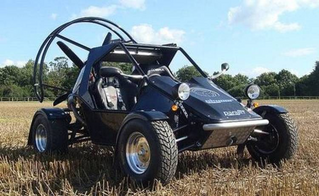World's Largest Flying Car Archive (Part 3 of 3)
- Story Cars
- Nov 16, 2021
- 16 min read
Updated: Nov 4, 2024
A flying car or roadable aircraft is a type of vehicle that can function as both a personal car and an aircraft. The term "flying car" is also sometimes used to include hovercars.
Many prototypes have been built since the early 20th century, using a variety of flight technologies. Although VTOL projects are increasing, most have been designed to take off and land conventionally using a runway. None has yet been built in more than a handful of numbers.
Flying cars are also a popular theme in fantasy and science fiction stories. Futurologists often predict their appearance, and many concept designs have been promoted. But their failure to become a practical reality has led to the catchphrase "Where's my flying car?" as a paradigm for the failure of predicted technologies to appear. For the sake of this article, Story Cars will cover the flying concepts, projects, and prototypes of the 20th and 21st centuries.
Part 3 of 3 includes every 2000 - current flying car known to the internet and eBooks. Comment below if any are missing from the archive.
Part 1
Part 2
Part 3
2000s Aerocar 2000
2000s SkyRider X2R
2000s Urban Aeronautics X-Hawk
2005 Monster Garage "Red Baron"
2006 Terrafugia Transition
2008 I-TEC Maverick
2009 Parajet Skycar
2009 Butterfly Super Sky Cycle
2011 Scaled Composites Model 367 BiPod
2012 PAL-V Liberty
AeroMobil Roadable Aircrafts
2018 Audi Pop.Up Next
2021 Klein Vision AirCar
2021 Plane Driven PD-1
2023 Mansory Empower Concept
2000s Aerocar 2000

The Aerocar 2000 was a proposed flying car under development in the early 2000s in the United States. The Aerocar 2000 was designed by Ed Sweeney, who was inspired by Moulton Taylor's Aerocar of the 1950s (and is the owner of the only still-flying example of this vehicle). The Aerocar 2000 consisted of removable wings, tail, and powerplant "flight module" added to a modified Lotus Elise roadster.
In conception, this was far closer to the AVE Mizar of the early 1970s than Taylor's designs, the vehicle portions of which were purpose-designed and built. Another difference with the original Aerocar (and similarity to the Mizar) is that the flight module is not designed to be taken away from the airfield. Finally, while the Aerocar used one engine to drive both the road wheels and the propeller, the Aerocar 2000 (again like the Mizar) uses two separate engines. In the Aerocar 2000's case, the flight engine is a twin-turbocharged V-8 motor from a Lotus Esprit. A far lighter three-cylinder engine and gearbox from a Chevrolet Sprint are to be installed in the road module to power the vehicle on the ground.
2000s SkyRider X2R

The SkyRider X2R is a flying car design developed by Macro Industries. The SkyRider incorporates rigid, lightweight composites for reduced structural weight. It utilizes four-ducted fans with wings to generate lift and maintain flight and uses control systems and onboard computers to generate a travel path to reach a destination given by voice commands.
While still in the prototype phase, the SkyRider is estimated to cost between $500,000 to $1 million, although the price is expected to drop to $50,000 if it reaches mass production. In the early 2000s, Macro Industries planned but failed to have an operational prototype by 2005. In 2010, Macro Industries designed and proposed a militarized version of its SkyRider for the DARPA Transformer program. This has not been built as of July 2017.
2000s Urban Aeronautics X-Hawk

The Urban Aeronautics X-Hawk is a proposed flying car designed by Rafi Yoeli in Yavne, Israel, built by Metro Skyways Ltd., a subsidiary of Yoeli's privately held company, Urban Aeronautics. The firm claims to have flown the car to a height of 90 cm (3 ft) and that greater heights are possible. The X-Hawk and its smaller unmanned version, the Tactical Robotics Cormorant, would be used in search and rescue operations where a helicopter would be useless, or at least very dangerous, such as evacuating people from the upper stories of burning buildings or delivering and extracting police and soldiers while very close to structures, narrow streets, and confined spaces, with a projected size similar to that of a large van.
Urban Aeronautics Ltd. patented its design as Fancraft. Fancraft technologies had registered 37 patents, with 12 additional patents pending in 2013.
Metro Skyways Ltd. (MSL), a subsidiary of Urban Aeronautics Ltd., led in developing the X-Hawk and exercises exclusive license of manned air-taxi (civil), air-rescue, and medical evacuation markets. Another subsidiary, Tactical Robotics Ltd. (TRL) has taken the lead in developing the Cormorant (formerly AirMule) and exercises exclusive licenses in unmanned military and national security markets.
In 2004, the development and the proof-of-concept vehicle CityHawk completed more than 10 hours of hover testing near Ben Gurion Airport in Israel. Its success encouraged the development of the X-Hawk and the Mule, since renamed Cormorant. Shortly after, Urban Aeronautics published the X-Hawk LE concept. Development is being done in parallel to the primary effort put into the Tactical Robotics Cormorant.
Urban Aeronautics plans to begin testing its CityHawk eVTOL in 2021.
The X-Hawk is a vertical take-off and landing (VTOL) aircraft with no exposed rotors, configured as a tandem-fan, turbine-powered vehicle. Pilots will use a fly-by-wire multi-channel flight control system with automatic stabilization to help control the aircraft and maintain level flight. The ducted fan design allows the car to achieve the speed and maneuverability of a helicopter.
Variants:
CityHawk prototype can carry two people, stay aloft for close to one hour, maximum ceiling estimated to be 8,000 ft (2,400 m), with flight speeds of 150–170 km/h (80–90 kn). Merely 2.2 m × 4.7 m (7.2 ft × 15.4 ft) in size.
X-Hawk LE is a more powerful version for law enforcement, one pilot + 3 officers, three h plus reserve at 259 km/h (140 kn).
X-Hawk EMS is for emergency medical services.
2005 Monster Garage "Red Baron"
The goal isn't actually to get airborne--the first flight is scheduled to happen about a month later, but anything is possible on Monster Garage.
Engineer Neal Willford designed a custom airfoil shape that generates more lift at a smaller angle of attack so the flying car won't need to rotate. Jesse won't have to pull back hard on the stick--which might make him over control and go too high.
The flying car has two engines: the V8 Ford engine coupled to the rear wheels and the Lycoming that drives the pusher prop. The V8 accelerates the heavy (3800 pounds) vehicle to liftoff speed. (A Cessna powered by the same engine weighs less than 2300.) The 320-cu.-in. flat Four Lycoming engine generates about 160 hp at takeoff rpm. That's enough power to keep the flying car flying but not enough to let it climb out of the ground effect.
2006 Terrafugia Transition
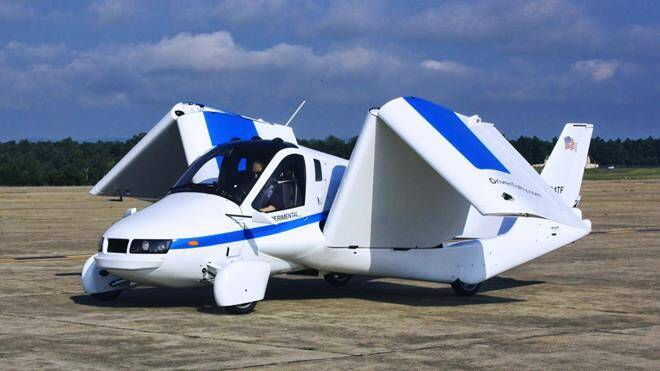
The Terrafugia Transition is a light sport, roadable airplane under development by Terrafugia since 2006. The Rotax 912ULS piston engine-powered, carbon-fiber vehicle is planned to have a flight range of 425 nmi (489 mi; 787 km) using either automotive premium grade unleaded gasoline or 100LL avgas and a cruising flight speed of 93 kn (107 mph; 172 km/h). Equipment includes a Dynon Skyview glass panel avionics system, an airframe parachute, and an optional autopilot.
On the road, it can drive up to 70 miles per hour (110 km/h) with normal traffic. The Transition Production Prototype's folded dimensions of 6 ft 8 in (2.03 m) high, 7 ft 6 in (2.29 m) wide, and 18 ft 9 in (5.72 m) long are designed to fit within a standard household garage. When operated as a car, the engine power take-off near the propeller engages a variable-diameter pulley CVT automatic transmission to send power to the trailing-suspension mounted rear wheels via half-shafts powering belt drives. In-flight, the engine drives a pusher propeller. The Transition has folding wings and a twin tail.
Additional Terrafugia Roadable Aircraft Concepts:
DARPA Transformer (TX) Project: A DARPA US$65m, five years, a three-phase program intended to develop a 'flying Humvee.' A Phase 1 proposal from AAI Corporation was awarded a US$3m contract in September 2010 and incorporates deployable surfaces technology from subcontractor Terrafugia.
Terrafugia TF-X: On May 7, 2013, Terrafugia announced the successor of Transition, called the TF-X. TF-X is a plug-in hybrid tilt-rotor vehicle and would be the first fully autonomous flying car. It has a range of 500 miles (800 km; 430 nmi) per flight, and batteries are rechargeable by the engine. It is expected to hit the market at least six years after Transition (2023).
2008 I-TEC Maverick
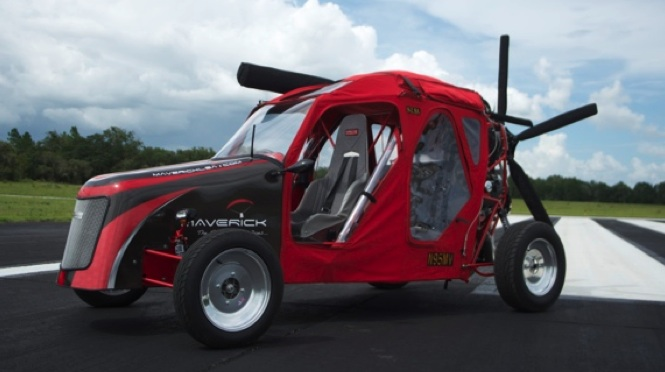
The ITEC Maverick is a powered parachute aircraft with a roadable fuselage. Equipped with the largest powered parachute certified by the FAA, the Maverick received experimental aircraft airworthiness certification on April 14, 2008, with N-Number 356MV.
Capable of interstate speeds on pavement, the Maverick's dune buggy-like frame of chromoly tubing gives it the ability to be used off-road. Additionally, the vehicle can deploy a parafoil and fly as a powered parachute. It weighs about 1100 pounds and has a useful carrying capacity equivalent to a Cessna 172 (fuel and 550 pounds cargo). With a 22-foot mast, the Maverick can take off and land in weather conditions that other powered parachutes would not be able to operate in safely. Steve Saint has said he envisions the Maverick being useful to the Huaorani and other Indian groups, farmers and ranchers, pipeline inspection crews, and anyone else with a requirement to traverse rough, roadless ground. Popular Mechanics gave it their Breakthrough Award in 2009. In 2012, the Maverick was accepted by the United States FAA to operate as an Experimental homebuilt, S-LSA, or E-LSA
2009 Parajet SkyCar
The Parajet SkyCar is a roadable aircraft (or PAV) developed by British paramotor manufacturer Parajet, a subsidiary of Gilo Industries. It utilizes a paramotor and a Paramania ParaWing (a parafoil) attached to a roadworthy vehicle to achieve sustained level flight. Should the engine fail, the vehicle can glide back to the ground. In the event of catastrophic wing failure, car connection system failure, or mid-air collision, an emergency ballistic reserve parachute would be deployed. It requires three minutes to convert it from a car to an aircraft. The prototype model runs on biodiesel and is fully road-legal.
An expedition team led by Neil Laughton set out on 15 January 2009 to fly and drive the SkyCar from London to Timbuktu. After the Civil Aviation Authority failed to grant permits in time due to confusion over how to categorize the SkyCar, the team decided to start flying the SkyCar from northern France, however, this was also not possible without permission from the CAA, and the skycar was driven to southern Spain. Neil Laughton managed to fly across the Straits of Gibraltar, damaging the car on landing in Morocco. After repairs, the car was driven to Mauritania, where the team made a couple of short flights. Although the car was designed for two people, it never flew successfully with more than a driver/pilot. The flying portion of the expedition eventually ended when inventor Gilo Cardozo crashed into a tree in the sparsely vegetated desert while attempting to take-off for a third flight. The team deemed the expedition completed on February 25, 2009 and returned the Skycar to Wiltshire, England.
2009 Butterfly Super Sky Cycle

The Butterfly Super Sky Cycle is an American homebuilt roadable gyroplane designed and manufactured by The Butterfly Aircraft LLC. The Super Sky Cycle is a pusher gyroplane with tricycle undercarriage and belt drive propulsion. A second two-cycle engine drives the main wheels. A kevlar tail provides directional control in flight. The rotors can be folded for road travel. Two 5 U.S. gallons (19 L; 4.2 imp gal) tanks are mounted in reserve.
2011 Scaled Composites Model 367 BiPod

The team at Scaled Composites pulled out all the stops to realize the final design of the company's founder and former CTO, Burt Rutan, ahead of his retirement in April earlier this year. In just four months, the Scaled Composites team went from beginning the preliminary design to the first flight of the "BiPod," a hybrid gasoline-electric flying car that grew out of a program to develop a rapid, low-cost electric testbed using as many off-the-shelf components as possible.
Rutan's Scaled Composites is the company behind a string of groundbreaking aircraft, including the GlobalFlyer, the sub-orbital spaceplanes SpaceShipOne and SpaceShipTwo, and its launch aircraft White Knight Two. But while he wasn't busy with those projects, Rutan was also toying with the idea of a personal electric aircraft, including VTOL (vertical take-off and landing) and roadable concepts.
When those working on the BiPod program realized that many of the propulsion system characteristics of their electric test-bed vehicle aligned with the drivetrain needs of a roadable vehicle, they expanded the research program to include a "flying car" airframe.
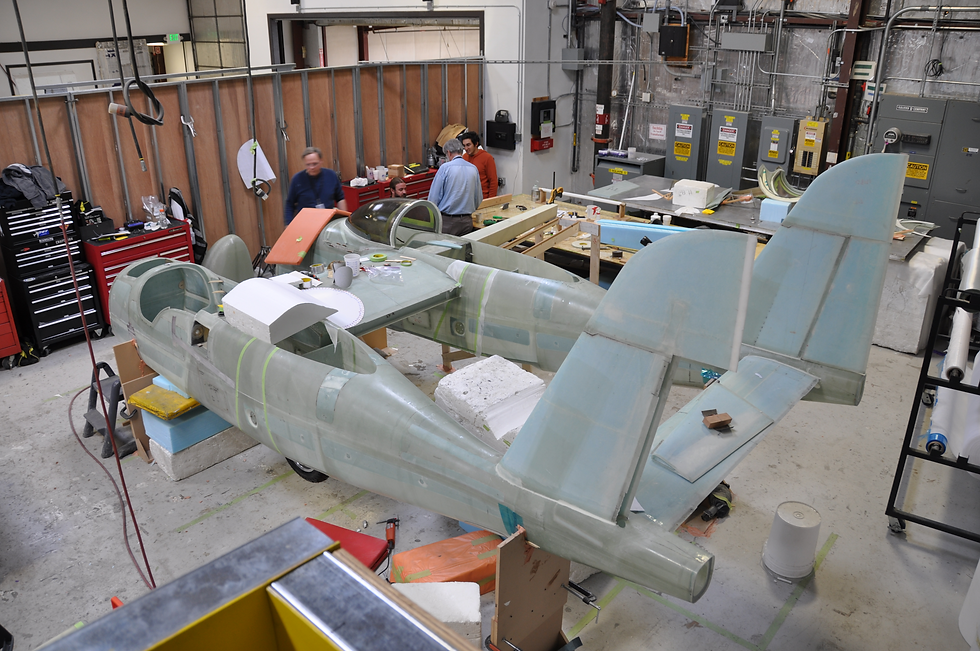
The result was an entirely new design with the ability to operate as a high-performance airplane with STOL (short take-off and landing) capabilities, a 200 mph (322 km/h) maximum speed, and range of 700 miles (1,127 km) or as a road commuter vehicle capable of freeway speeds, urban driving and garage storage.
Designed for the dual emphasis of safe ground operations and efficient high-speed flight, the BiPod features a twin-fuselage configuration with a 4-wheeled chassis with two cockpits - the left-hand cockpit used for ground driving and the right-hand cockpit used for flight. There is also a protected storage area for stowing the wings and tail surfaces during ground operations.
This unique configuration is enabled through electric power transmission, which decouples the engine location from the propeller location without the need for mechanical shafts and gearboxes. The craft has two 450cc internal-combustion engines, one per fuselage, which provide electrical power to the rear wheels and propellers located on the horizontal stabilizer by way of a generator. There are also lithium batteries located in the nose to provide additional energy for take-off and in case of an engine emergency.
While the propellers are yet to be fitted, the vehicle has already made several bunny hops along the company's main runway in Mojave, California, propelled by the rear wheels. The first "flight" took place on March 30, 2011.

Scaled Composites doesn't yet have any plans to commercially produce the vehicle, also known as Model 367, saying it is continuing to test and develop the BiPod configuration and hybrid propulsion system, intending to use similar systems on future aircraft configurations.
2012 PAL-V Liberty

2012 PAL-V Liberty
The PAL-V Liberty combines a car and an autogyro, or gyroplane under development by PAL-V. Both a driver's license and an autogyro pilot's license are required to operate the vehicle.
The company settled on a gyroplane design for several reasons. "The gyroplane principle not only provides us with a safe and easy-to-operate flying car but it also enables us to make it compact and within existing regulations, which is the most important factor to build a useable flying car," said Mike Stekelenburg, Chief Engineer at PAL-V. Pilots will require a Private pilot license) with a gyroplane rating to fly the PAL-V Liberty.
In addition, it also has a high center of gravity to make it stable in the air by allowing the propeller to act through the vertical center of gravity. In 2005, new technology by Carver provided a solution for the high center of gravity issue. Their Dynamic Curve Stabilizer System ensured the road safety of the 'roadable gyroplane.' On the ground, the propeller and rotor are stopped, and power is diverted to the wheels, allowing it to travel as a three-wheeled car, which will enable easier and safer take-off and landing.
In 2009, PAL-V tested the tilting system with Prototype X1 on the road. After the successful test, PAL-V started to build Prototype X2, also known as the PAL-V ONE. PAL-V made its first flight with the PAL-V ONE in 2012. At that time, the company was seeking funds to develop the type for production. The estimated unit price in 2012 was around €300,000. By proving this concept, PAL-V started the design of its first commercial flying car model based on proven technologies.
In February 2017, PAL-V started its marketing campaign with the public launch of the PAL-V Liberty and announced that they had started selling the first commercial flying car. The production model was first publicly shown at the Geneva Motor Show in Switzerland on March 6, 2018. CEO Robert Dingemanse expected then that all certification requirements would be completed by 2021.

PAL-V Liberty Sport Edition
PAL-V has two different versions, the Liberty Sport and the Liberty Pioneer. The Sport edition is the base model. The Pioneer Edition is the limited edition model. This model will be delivered before any other version and includes all available options. Sport prices were expected to start from €300,000, and the Pioneer edition will be €500,000.

PAL-V Liberty Pioneer Edition
After delivering 90 Pioneer Editions, PAL-V will start shipping the Sport Edition. The first delivery is expected to be in 2021.

PAL-V (Publicly Launching in the 2017 Geneva Motor Show)
On March 9, 2020, the company VP, international business development, Carlo Maasbommel, signed a Memorandum of Understanding with the Indian state of Gujarat to set up a manufacturing and export plant there. The company aimed to export PAL-V from India to the US, the Netherlands, the UK, etc., by 2021.
AeroMobil Roadable Aircrafts

2014 AeroMobil 3.0
The AeroMobil s.r.o. AeroMobil is a prototype roadable aircraft, designed by Štefan Klein and first flown in 2013. Slovak company AeroMobil s.r.o will produce the aircraft.
AeroMobil s.r.o. company co-founder and CEO Juraj Vaculík indicated in March 2015 that the vehicle is intended for "wealthy supercar buyers and flight enthusiasts." Aeromobil unveiled the vehicle's production version in April 2017 and announced that it would be available for preorder before the end of 2017.
The prototype was conceived as a vehicle that can be converted from an automobile to an aircraft. The version 2.5 proof-of-concept took 20 years to develop, and first flew in 2013. The prototype was constructed by the AeroMobil Team, based in Bratislava, Slovakia, and led by co-founders Štefan Klein and Juraj Vaculík, advised by inventor Dean Kamen.
As of 2013, there have been four developmental versions of the Aeromobil, 1.0, 2.0, 2.5, and 3.0, with earlier versions lacking folding wings, while later versions have folding wings and fins around the wheels. Version 2.5 was first exhibited in Montreal at the SAE AeroTech Congress and Exhibition. Version 3.0 was introduced at the Pioneers Festival 2014 in Vienna, Austria, and flew in October 2014. The designers intend to include a ballistic parachute.
In 2014 the company said there was no date for a finished product, but in 2015, after the prototype crash, they hoped for deliveries by 2018.
On 6 April 2016, the company raised €3 million ($3.2 million US) to help fund the production and demonstration of a new vehicle. This round of funding comes from individual investor Patrick Hessel, a founder of c2i. The company, c2i, is a maker of aerospace and automotive parts constructed from composite material.
On 20 April 2017, AeroMobil s.r.o. unveiled the vehicle's production model at Top Marques Monaco in Monte Carlo, Monaco, and announced that it would begin to take preorders for a "limited first edition" of it before the end of 2017. The first edition was to consist of no more than 500 vehicles, and the first 25 ordered were planned as a "Founders Edition" with "series-specific product content along with an expanded benefits package" with "details to be announced separately."
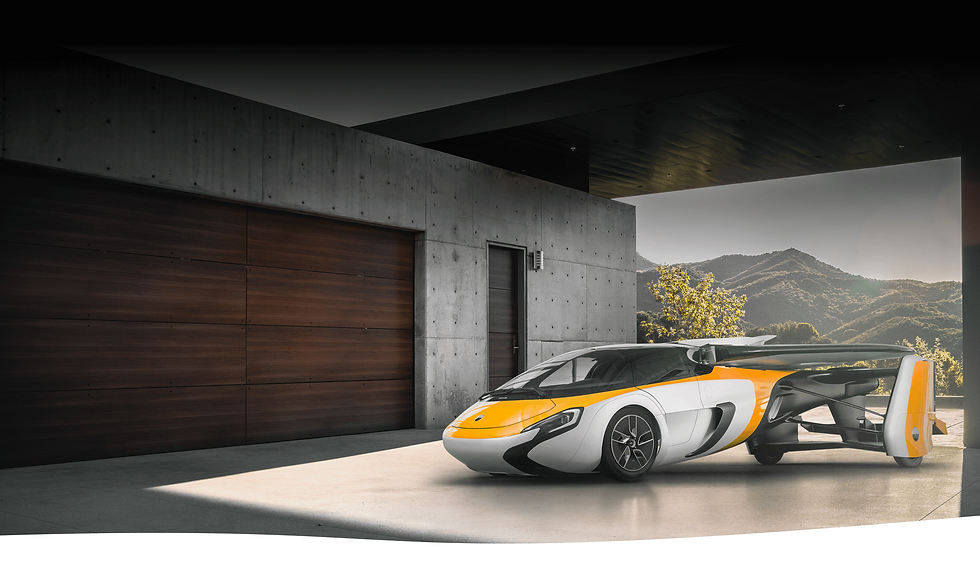
2017 AeroMobil 4.0
Variants
AeroMobil 1.0 (1990–94): Initial concept vehicle.
AeroMobil 2.0 (1995-2010): Concept development.
AeroMobil 2.5 (2010-2013): The pre-prototype of the Aeromobil concept.
AeroMobil 3.0 (2014-2017): further development of the concept. First publicly shown in October 2014 and crashed on 8 May 2015. Powered by a Rotax 912S engine, it was constructed with a steel frame covered in carbon fiber.
AeroMobil 4.0 (2017-): Hybrid power based on a Subaru boxer engine. 300 hp gasoline or 110 hp electric.
2018 Audi Pop.Up Next

The Audi Pop.Up Next is a conceptual unmanned flying electric vehicle that can move both on the ground and through the air of the joint development of the German automaker Audi AG, the Airbus company, and the design company Italdesign Giugiaro. It was first presented at the Geneva Motor Show in 2018.
2021 Klein Vision AirCar

The Klein Vision AirCar is a prototype two-seat flying car designed by Štefan Klein and made in Slovakia. Slovakian designer Professor Štefan Klein began working on flying cars in the late 1980s. Having developed the AeroMobil, he left the company to develop a new idea as the AirCar and set up Klein Vision with colleague Anton Zajac.
The main fuselage of the AirCar doubles as a two-seat road car with four large road wheels. Styled like a sports coupe, it contributes 30-40 percent of the total lift when in the air. For flight, it is fitted with foldout wings and extending tail booms carrying a high tail. A pusher propeller is permanently installed between the fuselage and tail, and a safety parachute is installed. Construction is primarily a semi-monocoque of carbon fiber composite over a steel subframe. Over 20 programmable servo motors are used to perform the transition between road and air configurations. When on the road, the retracted tail surface creates a downforce similar to conventional rear aerofoils.

Power is provided by a 1.6 liter BMW road car engine, running on automotive petrol or gasoline and delivering 104 kilowatts (139 hp).
The prototype AirCar is of comparable length to a Mercedes S-Class saloon, at 5.2 meters (17 ft 1 in) and around 2 cm (1 in) narrower. Overall weight is 1,100 kilograms (2,400 lb).
A second pre-production prototype is expected to have a monocoque fuselage with a more powerful 300 horsepower (220 kW) engine.
The prototype takes off at around 120 kilometers per hour (75 mph) after 300 meters (980 ft) run. Cruising speed in the air is said to be 170 kilometers per hour (92 kn). The range is estimated as 1,000 kilometers (620 mi) at the height of 8,200 feet (2,500 m). It is said to take two minutes and 15 seconds to transform from the car into aircraft.
The prototype first flew on 22 or 27 October 2020. In June 2021, the prototype AirCar carried out a 35-mile flight between Nitra and Bratislava airports. It has yet to receive flight certification for sales.
2021 Plane Driven PD-1

The Plane Driven PD-1 is modified to the Glasair Sportsman 2+2 to convert it into a practical roadable aircraft. The approach is novel in that it uses a mostly-stock aircraft with a modified landing gear "pod" that carries a separate engine for road propulsion.
The PD-1's wings fold along its sides, and the main landing gear and road engine pod slide aft along special rails, creating a driving configuration. The driving configuration compensates for the rearward center of gravity created by the folded wings and provides additional stability for road travel.
Trey Johnson, an award-winning homebuilt aircraft builder, took on the challenge of making a roadable aircraft. The PD-1 is intended to be an aircraft first and a car second. The vehicle can cruise at a speed of up to 140 mph in normal flight, even with the road engine sitting dead weight.
The engine pod carries a separate engine for road travel with its fuel tank. The wheels are driven through an automatic transmission with a reverse gear. The lightweight fuselage coupled with a low power engine allows 25 miles per US gallon (9.4 L/100 km; 30 mpg‑imp) fuel economy with 5 US gallons (19 L) of usable fuel. The aircraft is registered in Washington state as a motorcycle due to its 3-wheel configuration.
The wings are hinged to rotate and fold back against the rear fuselage of the plane. The horizontal stabilizer is also hinged to reduce the width of the vehicle in road travel mode.
The prototype was constructed using Glasair's two weeks taxi program. It was started on March 29, 2010, and the modified prototype was test flown by July 21, 2010.
The prototype was displayed at the Experimental Aircraft Association Airventure airshow in 2010. The company's second-generation refinement was code-named the PD-X to build a marketable aircraft based on the PD-X test results.
Variants
PD-1
PD-2 A second-generation version of the PD-1 using the same Sportsman airframe as the PD-1. The PD-2 uses two forward-mounted wheels with suspension in a conventional landing gear layout. A single rear wheel is mounted aft on the pod containing the second engine for road use. An updated pod was developed using a 50 hp four-cycle engine with casters that fits into the baggage compartment. A custom lightweight four-piece carbon-fiber ramp can be used to load the pod without lifting. Gas mileage is 24mpg in-ground use.
2023 Mansory Empower Concept
The Mansory Empower Concept, revealed in 2023, showcases a visionary leap into the future of flying vehicles by completely eliminating traditional wheels. Its sleek design draws inspiration from hypercars, featuring aerodynamic curves and large windows for an immersive experience, along with dramatic upward-opening doors. While specific technical details remain undisclosed, the concept hints at advanced technologies for vertical takeoff and landing, aligning with the industry's shift toward electric and sustainable mobility. As Mansory prepares to transform luxury vehicles in 2024, the Empower Concept serves as an exciting preview of a future where flying cars become a reality.
Sources:












